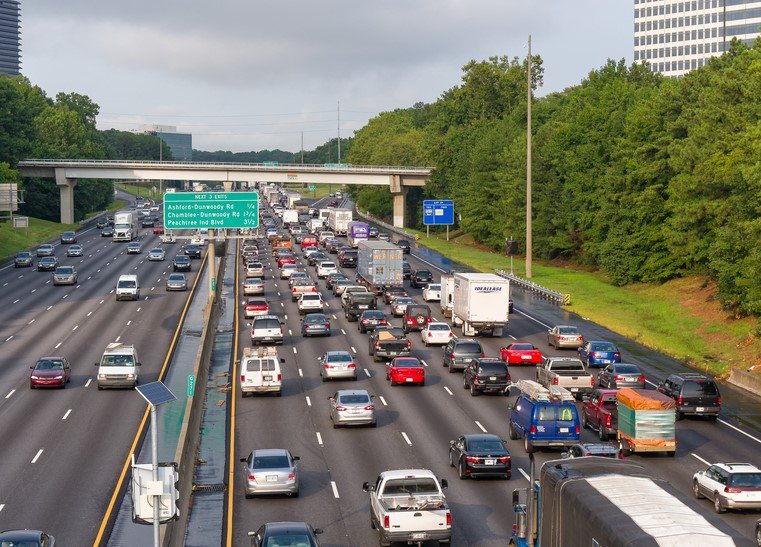Landmark public-private deal promises faster commutes, but not everyone’s cheering
In a move that’s stirring both celebration and criticism, the Trump administration has approved a $3.89 billion loan to overhaul a 16-mile stretch of Georgia’s Highway 400. The funding marks the largest single loan ever approved by the U.S. Department of Transportation and aims to relieve some of Atlanta’s notorious traffic headaches.
But while Georgia leaders are calling it a transformative infrastructure investment, questions remain about toll costs, private sector influence, and whether everyday drivers will really benefit.
The Deal: A Historic Infrastructure Bet
The numbers are big — and so is the ambition.
The loan, announced Tuesday by U.S. Transportation Secretary Sean Duffy, comes through the Build America Bureau and supports a public-private partnership involving the Georgia Department of Transportation (GDOT), the State Road and Tollway Authority, and SR 400 Peach Partners, LLC.
It’s all being made possible under the federal Transportation Infrastructure Finance and Innovation Act, or TIFIA.
“This is the single largest loan ever approved to a borrower,” Duffy said. “We’re investing in fast, reliable mobility, while supporting Georgia’s growth.”
The project will expand GA 400 from MARTA’s North Springs Station in Sandy Springs to just beyond McFarland Parkway in Forsyth County, a vital commuter corridor. Lanes in both directions will be added — express toll lanes, to be precise.

Kemp’s Backing and Peach Partners’ Sweet Deal
Governor Brian Kemp wasted no time praising the move. “This is the largest public-private partnership in USDOT history!” he wrote on social media, tagging both President Trump and Secretary Duffy in a celebratory post.
Peach Partners, the private firm heading the project alongside state agencies, is chipping in an additional $75 million for future bus rapid transit infrastructure — a sweetener meant to bolster the project’s appeal to transit advocates.
What do they get in return? Long-term toll revenue rights and development opportunities tied to corridor growth.
Critics have raised eyebrows, of course. Some transit watchers say private interests could prioritize profit over equitable access.
But for now, the deal is done.
Commute Time Cuts — On Paper, At Least
The project’s supporters are touting some pretty bold benefits.
According to GDOT, the new toll lanes are expected to reduce traffic delays by more than 19,000 hours daily. That translates to around 15 minutes saved per commuter, per trip. Over a week? That’s more than an hour of your life back.
Still, skeptics warn that travel time estimates are notoriously optimistic in early project phases. And toll lane usage depends heavily on pricing models and enforcement.
Here’s what drivers are being promised:
-
16 miles of new toll lanes
-
Express bus access via future BRT service
-
Traffic delay reductions of 19,000+ hours per day
-
Reduced carbon emissions through less idling
But, as always, results will depend on execution — and whether commuters can actually afford the tolls.
What It Means for Metro Atlanta
Metro Atlanta’s sprawl has long been a traffic-plagued nightmare. With rapid suburban growth and limited mass transit options, roads like GA 400 bear the brunt of rush-hour misery.
This project could be a turning point — or just another expensive Band-Aid.
The toll lane model, already tested on I-75 and I-85 in Georgia, has produced mixed reactions. While some users praise the time savings, others complain about rising toll rates during peak hours.
One commuter told Atlanta News First: “It helps if you’ve got the money. Otherwise, it’s the same old jam.”
And that’s the crux of the debate — accessibility vs efficiency. Equity vs convenience.
Follow the Money: How It All Adds Up
The $3.89 billion loan isn’t a blank check. It’s structured financing, backed by projected toll revenue and state contributions. TIFIA loans often come with favorable repayment terms, allowing states and private partners to delay heavy payments until revenue flows.
Let’s break it down:
| Component | Amount (USD) |
|---|---|
| Federal TIFIA Loan | $3.89 billion |
| Peach Partners BRT Funding | $75 million |
| State Contributions | Undisclosed (est. $400M) |
| Toll Revenue Projections | ~$200M/year (by 2030) |
The loan covers a major portion of the upfront cost — but long-term sustainability depends on steady ridership and congestion pricing.
The math only works if the traffic doesn’t.
Not Everyone’s on Board
While officials cheer, some residents aren’t sold.
Local advocacy groups have raised concerns about toll fairness, environmental impact, and the long-term footprint of expanding highway infrastructure over investing in mass transit.
“There’s no such thing as free-flowing traffic in Atlanta,” said one resident during a community forum in Alpharetta. “All they’re doing is adding pay-to-play lanes.”
Environmental groups have also flagged the potential sprawl effects, warning that new lanes often induce more traffic instead of alleviating it. Others question why MARTA expansion hasn’t been more aggressively prioritized.
Then again, Georgia’s politics have never made transit planning easy.
